Research Article: Journal of Drug and Alcohol Research (2024) Volume 13, Issue 2
Unravelling the Impact of Alcohol Use on College Students' Educational Success: A Systematic analysis
Madhavi Sripathi1, T.S. Leelavati1, P. Varaprasad Goud2, C. Kavitha3, M. Vijay Kumar4, B. Lakshmi5 and Shaik Aminabee6*2Chaitanya Bharathi Institute of Technology, India
3RBVRR Women’s College, India
4Andhra Loyola Institute of Engineering and Technology, India
5Natioanl Institute of Pharmaceutical Education and Research, India
6Department of Pharmacology, V.V. Institute of Pharmaceutical Sciences, India
Shaik Aminabee, Department of Pharmacology, V.V. Institute of Pharmaceutical Sciences, India, Email: aminaammi786@gmail.com
Received: 31-Jan-2024, Manuscript No. JDAR-24-128029; Editor assigned: 02-Feb-2024, Pre QC No. JDAR-24-128029 (PQ); Reviewed: 16-Feb-2024, QC No. JDAR-24-128029; Revised: 21-Feb-2024, Manuscript No. JDAR-24-128029 (R); Published: 28-Feb-2024, DOI: 10.4303/JDAR/236283
Abstract
In recent years, the impact of alcohol use on the academic performance of college students has been a subject of growing concern. This systematic meta-analysis aims to unravel the nuanced relationship between alcohol consumption and educational success, providing a comprehensive synthesis of current research findings. This study delves into the connection between alcohol consumption and diverse educational results. An extensive data analysis spanning 16 states examines how alcohol use among children aged 11 to 15 correlates with their academic performance and assesses the disparities among these states. Additionally, a longitudinal analysis delves into the potential causal relationship between alcohol use and both educational achievement and attainment across 16 states. This study also delves into the wider consequences of the connection between alcohol and educational outcomes, considering the effects on individuals and the economy.
Keywords
Alcohol use; College students; Academic performance; Educational success; Systematic review; Meta-analysis
Introduction
Alcohol consumption among college students has long been a subject of concern due to its potential influence on their academic performance and overall well-being. The transition to higher education often coincides with newfound independence and social pressures, making young adults particularly susceptible to engaging in alcohol-related behaviours. While moderate and responsible alcohol use can be a part of the college experience for many students, excessive or problematic drinking patterns may lead to adverse consequences, including detrimental effects on academic achievement.
The relationship between alcohol use and academic performance is multifaceted and complex, influenced by a myriad of factors such as frequency of consumption, binge drinking, gender, socioeconomic status, and age [1]. Understanding this intricate interplay is essential not only for academic institutions but also for public health initiatives aiming to support the well-being of college students.
• Frequency of consumption: The frequency of alcohol consumption refers to how often a student drinks. Students who consume alcohol more frequently may be at greater risk of experiencing negative academic consequences, especially if their drinking habits are excessive and uncontrolled.
• Binge drinking: Binge drinking is characterized by the consumption of large amounts of alcohol within a short period. It is a behaviour commonly observed among college students, and it can have a significant impact on academic performance. Binge drinking is associated with various adverse outcomes, including missed classes, impaired cognitive function, and a higher likelihood of academic probation.
• Gender: Gender differences play a role in how alcohol affects academic performance. For instance, research has shown that males and females may respond differently to alcohol, both in terms of its physiological effects and its impact on academic outcomes. Some studies have suggested that females may be more sensitive to the negative academic effects of alcohol.
• Socioeconomic status: Students’ socioeconomic status, including their family background and financial resources, can influence their drinking habits and academic performance. Socioeconomic factors can affect access to alcohol, as well as the stressors and responsibilities students’ face, which, in turn, can affect their ability to balance academics and social activities.
• Age: The age at which college students begin consuming alcohol can also be a factor.
Students who initiate drinking at a younger age may be more likely to develop problematic drinking patterns that can hinder their academic progress. Conversely older students may have more maturity and better coping mechanisms (Figure 1). This systematic meta-analysis aims to unravel the nuanced association between alcohol use and educational success among college students. By synthesizing and analysing a comprehensive selection of empirical studies, this research seeks to provide a deeper and more holistic understanding of how alcohol consumption may impact academic outcomes. In doing so, it aims to shed light on the extent to which alcohol use influences GPA, course completion, and academic progression and to identify potential moderating factors that can help inform targeted interventions and policies to promote responsible drinking behaviours and enhance the educational experience for college students.
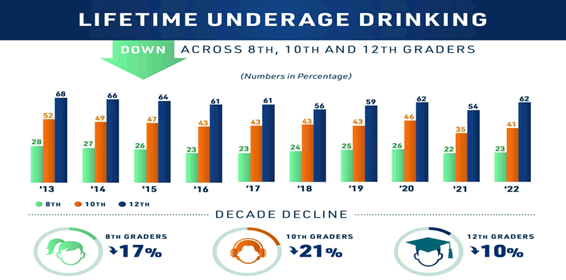
Figure 1: Lifetime underage drinking
Literature Review
The existing body of literature examining the relationship between alcohol use and educational outcomes predominantly relies on cross-sectional studies [2-4]. However, research based on longitudinal data, which can shed light on the sequence in which alcohol use precedes changes in educational outcomes, offers a mixed set of findings. Several studies have presented evidence of a temporal link between alcohol consumption and educational results. For example, in a study conducted by Hemphill, et al. (2014), they scrutinized the impact of early adolescent alcohol use on mid-adolescent school suspension, truancy, commitment, and academic failure [5]. Their results indicated that grade 7 alcohol use and binge drinking were associated with grade 8 suspensions and grade 9 truancy, signifying a 68% higher likelihood of grade 8 suspensions among grade 7 alcohol users. Nevertheless, no significant impact on academic achievement and school commitment was detected. In another study that utilized data from the longitudinal Brain and Alcohol Research in College Students, they evaluated the influence of alcohol on students’ Grade Point Averages (GPAs) [6]. It was observed that students with moderate to high levels of alcohol use but low marijuana use had lower GPAs, although this difference became statistically non-significant over time. However, students using both substances consistently maintained lower GPAs throughout the two-year observation period. Conversely, several investigations failed to uncover a substantial impact of alcohol use on educational outcomes. For instance, a study using data from the US Add Health cohort, which examined the relationship between binge drinking and GPA, revealed no statistically significant correlation between the two [7]. Similarly, Silins et al. explored the association between adolescent alcohol use and educational attainment across three Australasian longitudinal cohorts, ultimately revealing weak and statistically insignificant links between the frequency of alcohol use and the failure to attain secondary school and tertiary qualifications after adjusting for confounding variables. In an analysis conducted by Chatterji, two distinct methodologies were employed to evaluate the connection between alcohol use during high school and educational attainment at age 26, using data from the US National Education Longitudinal Study [8]. Ordinary regression indicated an association between the two variables. However, the results from a model that accounted for the potential influence of common, unmeasured determinants suggested that alcohol use had no causal impact on educational attainment, despite the robust correlation between the variables. Furthermore, a separate study highlighted gender-specific disparities. Balsa, et al. (2011) harnessed the Add Health cohort to investigate the relationship between alcohol consumption and GPA, utilizing a fixed-effects model [9]. While alcohol consumption was linked to a slight but statistically significant reduction in GPAs for boys (0.07 points per 100 drinks per month), this effect did not attain statistical significance for girls.
Biological, emotional and behavioural factors
The link between alcohol use and education is influenced by a triad of fundamental elements: Biological, behavioural, and emotional components. Harmful alcohol consumption represents a significant risk factor across various demographic groups, with the practice of heavy episodic drinking, commonly known as binge drinking, being particularly prevalent among different age cohorts, notably among the youth. These behaviours, which come with an elevated risk, are intricately linked to a wide array of chronic health conditions, encompassing cancer, liver diseases, mental health disorders, and injuries. Moreover, beyond the extensive ramifications for public health, alcohol use in children and young individuals can also have consequences for their educational outcomes. The effect of alcohol on education emerges through the intricate interplay of these mediating factors: Biological behavioral, and emotional or mental health components (Figure 2). First and foremost, it’s essential to acknowledge that alcohol use and the related health issues, including mental health disorders, can have a direct biological influence on cognitive function and concentration within an educational context. Research has demonstrated that alcohol consumption can lead to neuro degeneration and impaired brain function [9]. Consequently, this can result in learning difficulties and hindered cognitive abilities [10]. Secondly, Alcohol use can induce behaviours that negatively affect academic performance, including higher rates of absenteeism and decreased commitment to school. Research has revealed a connection between alcohol use and instances of school absenteeism, diminished study time, and lower school attendance [4]. Thirdly, emotional and mental health aspects associated with alcohol use can also impact educational outcomes. Alcohol use has been demonstrated to have adverse effects on students’ relationships with their peers and teachers, as well as their dedication to schoolwork [5]. For example, student alcohol use can heighten the likelihood of disengagement from school, potentially leading to truancy or school suspension, and subsequently fostering associations with antisocial peers. Nonetheless, the relationship between alcohol use and educational outcomes is intricate and bidirectional, with the possibility of inverse associations. For example, students who experience academic difficulties may be more inclined to turn to binge drinking as a coping strategy, as emphasized by Donath, et al. in 2012 [11,12]. Additionally, various confounding factors, including family income, parental education, self-esteem, and motivation, can influence both the risk factors associated with alcohol use and educational outcomes. The presence of these confounders can either falsely imply a relationship that is not present or obscure or alter the genuine relationship. Regarding the relationship between alcohol use and bullying, these behaviors are intertwined. Alcohol use, bullying, and social exclusion are interconnected. Children who report frequent drunkenness are twice as likely to engage in antisocial behaviors toward their peers compared to those who abstain from alcohol entirely. For example, among boys, 50% of those who had encountered drunkenness 11 times or more in their lifetime reported engaging in bullying behavior with their classmates, while this figure stood at 24% among abstainers (Figure 3). There exists a negative association between alcohol use and life satisfaction, as indicated by survey data. Notably, this relationship is more pronounced when considering the frequency of drunkenness, particularly among girls. Specifically, girls who consistently abstained from alcohol reported life satisfaction scores that were 27% higher compared to those who had experienced intoxication on more than ten occasions. These variations in life satisfaction scores were substantial, with abstainers scoring 7.74 compared to frequent drinkers at 6.10, marking a significant 1.64-point difference on a 0 to 10 scale. Among boys, the difference in life satisfaction scores was 0.86 points, with abstainers at 7.99 and frequent drinkers at 7.13, indicating a 12% higher score for those who had consistently refrained from alcohol. What’s particularly intriguing is that the relationship between alcohol use and life satisfaction is both consistent and non-linear. The most significant decline in life satisfaction is evident between individuals who have consistently abstained from alcohol and those who have had at least one experience with alcohol without reaching a state of drunkenness. This suggests that the initial instance of drinking, as opposed to subsequent episodes or full-blown intoxication, has the most pronounced effect on emotional and mental wellbeing. From a policy standpoint, while reducing instances of drunkenness among children is undeniably important, tackling early initiation into alcohol consumption becomes an even more significant priority [13-19].
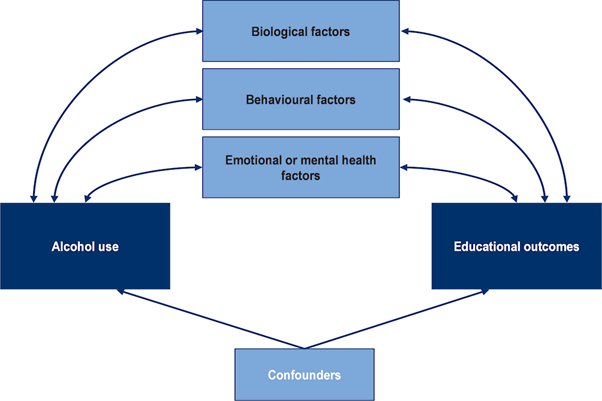
Figure 2: Effect of alcohol on education
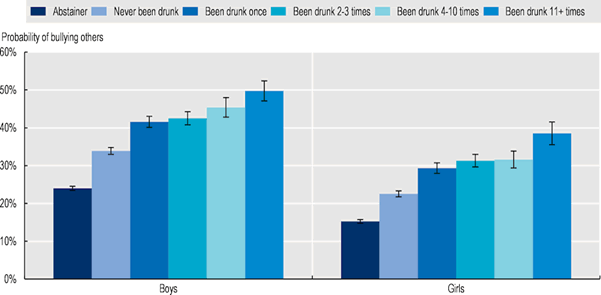
Figure 3: Probability of bullying
Life Satisfaction and Drunkenness Frequency
The variance in school performance associated with experiences of drunkenness has exhibited a slight increase in girls over recent years, while it has remained consistent in boys (Figure 4). An analysis that scrutinized shifts in academic performance from 2002 to 2014 across 16 states uncovered a slight but statistically significant reduction in academic achievement among girls who had previously encountered drunkenness [20-22]. Conversely, this pattern remained unchanged among girls who had never experienced drunkenness, leading to a marginal increase in the existing disparity in school performance among girls. For boys, the trends in academic performance exhibited a comparable pattern, with no discernible distinctions between those who had never engaged in drunkenness and those who had, thereby preserving a consistent level of inequality in their educational outcomes (Figure 5).
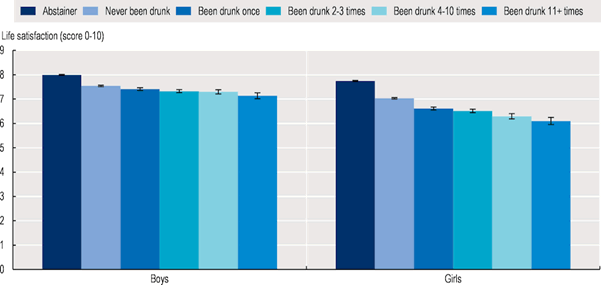
Figure 4: Life satisfaction and drunkenness frequency
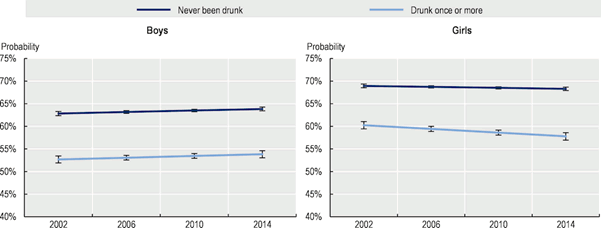
Figure 5: Probability of good academic performance: Gender
Discussion
The effects of alcohol use and the related health issues on the economy and society are widely acknowledged, particularly in terms of healthcare expenses, diminished productivity, and the repercussions of violence and accidents. However, extending beyond these extensively documented consequences, the connection between alcohol use and educational results carries significant ramifications for the development of human capital, economic progress, disparities in society, and overall social well-being. Academic achievement and educational results are fundamental elements in shaping an individual’s human capital development and their future socioeconomic standing. Furthermore, any deterioration in academic performance can exert a notable influence on a nation’s economic growth. Research has emphasized the prospective economic benefits linked to the enhancement of the cognitive abilities within a population, suggesting that even modest enhancements in the skills of the workforce can yield significant advantages for a nation’s future prosperity.
Conclusion
Additionally, the quality of educational outcomes emerges as a pivotal factor in bringing about this transformation. Discrepancies in health and behaviors related to health that result from early alcohol use can sustain pre-existing social disparities, consequently exerting a continued influence on the broader landscape of social welfare. These disparities in health during youth often extend into adulthood, contributing to inequalities in terms of employment opportunities and income disparities, as highlighted by Marmot, et al. in 2010. These disparities and injustices in society can present a substantial hurdle to a nation’s broader social well-being, particularly within the framework of developing countries that are earnestly striving to establish new and more potent rights for their citizens through initiatives such as the Indian Pillar of Social Rights. These rights encompass a wide array of elements, encompassing equal opportunities, entry into the labor market, fair working conditions, social safety nets, and inclusion. Hence, it is clear that mitigating the early onset of alcohol consumption and restraining initial alcohol use can serve as a pathway to forge more promising futures and cultivate more resilient societies. Policymakers should allocate funding towards a multifaceted set of policy endeavors designed to address underage drinking, combat bullying, and enhance the overall well-being and mental health of children. These efforts have the potential to enhance the quality of children’s lives by bolstering their academic achievements, improving their prospects in the future job market, and promoting their overall health and well-being.
Acknowledgement
None.
Conflict Of Interest
Authors have no conflict of interest to declare.
References
- T.S. Leelavati, S. Madhavi, G. Kamal, P.V.M Raju, K. Susmitha, et al. Revolutionizing Healthcare Delivery: Telemedicine's influence on access and patient satisfaction, Int J Chem Bio Chem Sci, 24(2023):106-115.
- W. El Ansari, C. Stock, C. Mills, Is alcohol consumption associated with poor academic achievement in university students? Int J Prev Med, 4(2013):1175-1188.
- J. DeSimone, A. Wolaver, Drinking and academic performance in high school, National bureau of economic research, Cambridge, MA, 2005.
- M. Holtes, Associations of truancy, perceived school performance, and mental health with alcohol consumption among adolescents, J Schl Hlth, 85(2015):852-860.
- S. Hemphill, Effects of early adolescent alcohol use on mid-adolescent school performance and connection: A longitudinal study of students in Victoria, Australia and Washington State, United States, J Schl Hlth, 84(2014):706-715.
- S. Meda, Longitudinal influence of alcohol and marijuana use on academic performance in college students, PLoS One, 12(2017):15-19.
- J. Sabia, Wastin' away in Margaritaville? New evidence on the academic effects of teenage binge drinking, Conty Eco Ply, 28(2010):1-22.
- P. Chatterji, Does alcohol use during high school affect educational attainment? Evidence from the National education longitudinal study, Eco Edu Rev, 25(2006):482-497.
- A. Balsa, L. Giuliano, M. French, The effects of alcohol use on academic achievement in high school, Eco Edu Rev, 30(2011):1-15.
- S. Brown, Neurocognitive functioning of adolescents: Effects of protracted alcohol use, Alc Clin Exp Res, 24(2000):164-171.
- C. Donath, Predictors of binge drinking in adolescents: Ultimate and distal factors-A representative study, BMC Pub Hlt, 12(2012):263-268.
- S. Boniface, J. Kneale, N. Shelton, Drinking pattern is more strongly associated with under-reporting of alcohol consumption than socio-demographic factors: Evidence from a mixed-methods study, BMC Public Health, 14(2014):12-97.
- T. Cole, Establishing a standard definition for child overweight and obesity worldwide: International survey, BMJ (Clinical Res Ed), 32(2000):1240-1243.
- European Commission Secretariat-General, European Pillar of Social Rights, 2018.
- A. Gilmore, C. Croft, N. Reid, Burt word reading test: New Zealand revision. Teacherâ??s manual, New Zealand council for educational research, Wellington, 1981.
- HBSC. Health behaviour in school-aged children: World Health Organization collaborative cross-national survey, University of St Andrews, 2020.
- M. Livingston, S. Callinan, Underreporting in alcohol surveys: Whose drinking is underestimated? J Stud Alc Drg, 76(2015):158-164.
- A. Nemtsov, Alcohol consumption in Russia: Is monitoring health conditions in the Russian Federation (RLMS) trustworthy? J Addiction, 99(2004):386-387.
- OECD, The high cost of low educational performance: The long-run economic impact of improving PISA outcomes, PISA, OECD Publishing, Paris, 2010.
- H. Oppewal, Concept of causality and conditions for causality,â? in wiley International encyclopedia of marketing, Jhn Wil Sn, Hoboken, NJ, 2010.
- U. D. Prasad. S. Madhavi, Prediction of churn behaviour of bank customers using data mining tools, Ind J Mark, 42(2012):25-30.
- M. Sripathi, A study on impact of false advertising on the consumer buying behaviour, J Intrdisc Cyc Res, 12(2020):1066-1074.
Copyright: © 2024 Madhavi Sripathi, et al. This is an open access article distributed under the terms of the Creative Commons Attribution License, which permits unrestricted use, distribution, and reproduction in any medium, provided the original work is properly cited.

